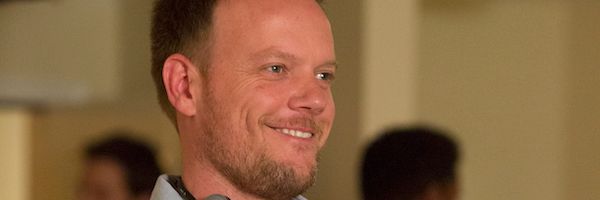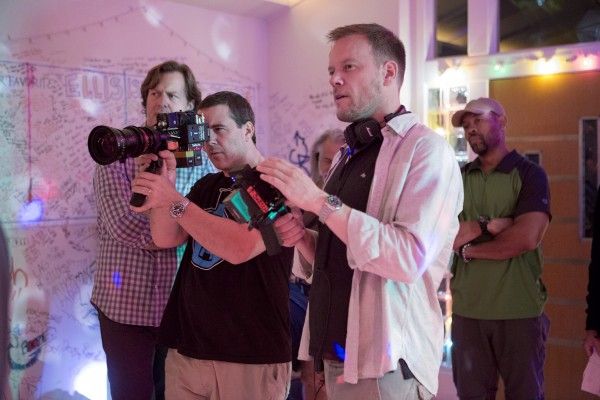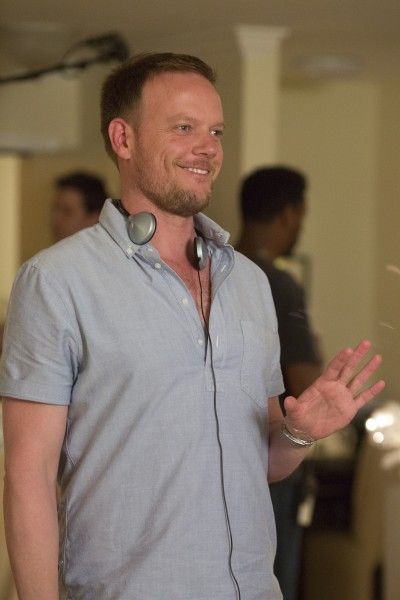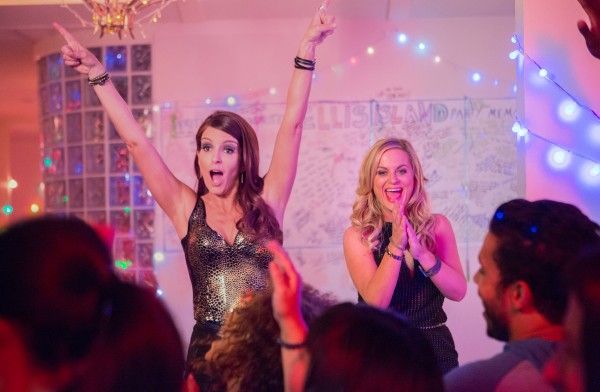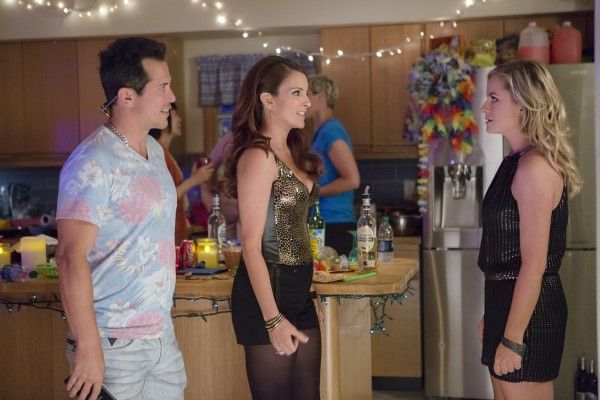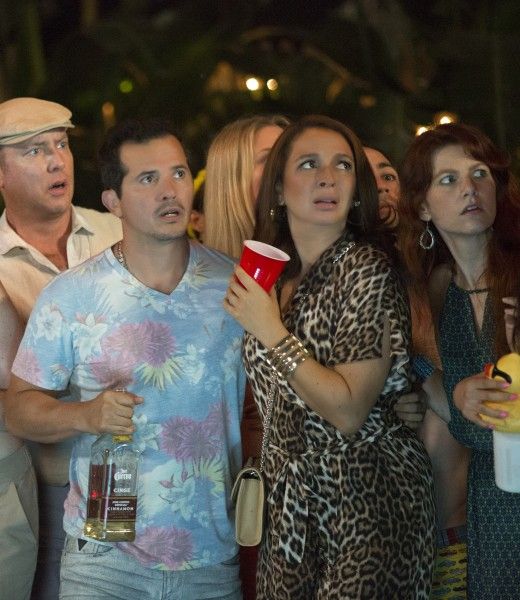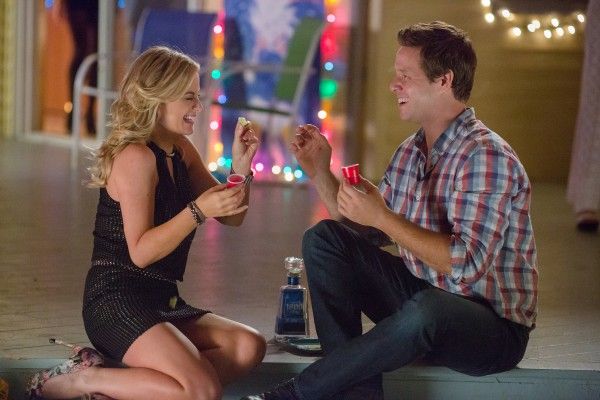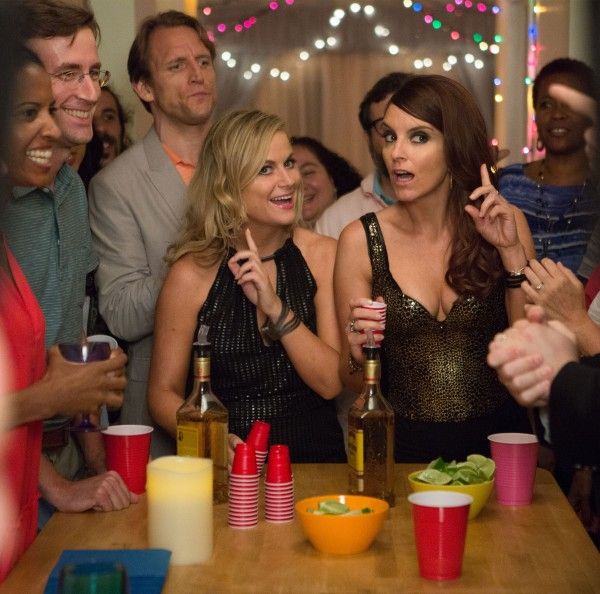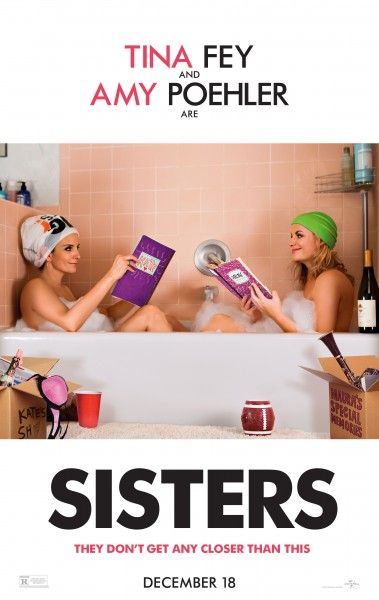Jason Moore’s hilarious new comedy, Sisters, reunites SNL comedy duo Tina Fey and Amy Poehler as 30-something siblings who discover their retired parents (James Brolin, Dianne Wiest) have sold the family home leaving them one weekend to clean out the old junk in their childhood bedroom before the new owners arrive. Their cathartic trip down memory lane while sorting through the artifacts of their teen years inspires them to throw one final house party for all their old friends. The ensuing chaos threatens to destroy the house and take down the entire neighborhood. Maya Rudolph, Ike Barinholtz, and John Cena also star.
In our exclusive interview, Moore talked about the story and the relationship between these women that made him want to direct the film, how Paula Pell’s journals and distinctive voice were key to how the film got started, their collaborative process on set, what the extraordinary cast brought to the project, the challenge of editing a film when you’ve got so many great performers doing alt humor, his talented behind-the-scenes team including DP Barry Peterson and production designer Richard Hoover, the decision to build the house on an indoor stage, and returning to Broadway to direct Jesse Tyler Ferguson from Modern Family in a one-man show. Check it all out in the interview below.
How did this project first emerge?
JASON MOORE: I was looking for other comic voices that I loved. I love Kay Cannon who is good friends with Tina and I was searching around. Who are those other funny women? Paula very quickly came to the top of the list. I followed her on Twitter, so I heard about this script and read it. Tina and Paula are old, dear friends. Paula had brought the project to Tina, and Tina was producing it. I read it and met with Paula and Tina, and eventually they were like, “Maybe this guy should direct it.” I came aboard and I was just so happy because I was working with two of the funniest ladies out there. Then, we developed more of the sister relationship and more of the story, more of the ‘who were you in high school and does that determine who you become as an adult’ kind of theme. Once we had that fleshed out, Tina was like, “I’d really love to play Kate, because I’d love to be doing something different than Liz Lemon.” Who wouldn’t? She’s been playing the same character so brilliantly for so long, but you want to break out. Once she wanted to do that, and I knew she’d be great at doing that, then Amy just seemed like what a fun choice to watch them play sisters and to switch places.
What was it about the story and the relationship between these two women that really resonated with you and made you say I’ve got to make this film?
MOORE: My favorite kinds of comedies are ones that hopefully make you laugh a lot, but ultimately make you care about something in the end, even if it’s just a little bit. If you can make someone tear up a little bit and feel something in their throat, those are the best kinds. That generally means that there's got to be some love in there. This felt like a genuine relationship between two sisters, and that’s mostly because it is based on Paula’s relationship with her own sisters and her own family. There’s a real truth underneath there, especially when we started to get this single theory of who you are starts to get defined when you are in high school, your place in the world, and some of the patterns that you get into as a person, or in your family, and the way that we go home to our families, and we suddenly behave like our parents’ children when we are 40 years old. It felt like there were some real things going on. Also, I had a father who died recently. I sold my parents’ home. It’s also more of how that really is a thing with people saying goodbye to some version of their childhood. That’s all a little heady, but ultimately, that’s why it was important to me, because at its root, it actually is about something. I believe that when your comedy is about something real, then you can be almost wilder and weirder with it, because you’re always coming back hopefully to something that feels authentic.
Tina had been working with Paula on this script for some time. How were Paula’s journals the key to how this film got started?
MOORE: The story goes, and I wasn’t around for this, so I think I’m retelling it correctly, which is that Paula had had these journals and knew how funny they were, and they had read them on set at SNL backstage, and they always made each other laugh. Paula was trying to figure out what her first movie should be, and either her agent or maybe it was Tina suggested that the heart of this seems like it could make a great movie. That was the way it was born and the journals became key. In fact, even when you watch the movie now, it’s that scene where you start to go, “Oh, I get what this movie is. I get it.” They are based on who they were. They’re going, “Wow, maybe I should have done something differently.” That’s what causes the whole thing to happen.
Pell has a distinctive voice and her script reflects layers of storytelling and well developed characters. What was it about her screenplay that made you feel you could turn this into a movie?
MOORE: I just believed the most important thing for me when I read it was that Paula’s comedy voice is so specific. It’s oddball, left of center, but very relatable. It’s highbrow and lowbrow at the same time. It’s loving. It’s not mean. It has joy in it and humor. Her voice is very special and specific. There’s a reason that she’s created so many of these characters on SNL and written jokes for so many amazing movies and comedy actors. That was the key for me. It was that her comic voice was so special. It’s rare when I read something. When I read something, a lot of times it will make me laugh, but rarely do I actually laugh out loud. That’s one of the tests for me. Then, the fact that it had this root of something truthful beneath it, I just thought this is for me personally that rare thing where it could be funny and about something.
What was your collaborative process like with Pell on set?
MOORE: She was there every single shooting day. I really wanted that. It is her voice. It is her story. I assumed this, but what I didn’t know until I really got there, which is, she can also write jokes, really funny ones, pretty much all day long. As long as she’s awake, she’s able to write funny jokes. She was by my side every day and by everybody’s side. She’s also a joyous, lovely, wonderful person. So, you get joy and support. There’s not any judgment. She’s there to make everybody look good, and people then want to make her look good and want that kind of exchange of fun. It made me laugh a lot. The only negative was that there was so much laughter around the video monitor a lot of times that I eventually had to just get my own monitor, because there were all these funny people making each other laugh that I couldn’t concentrate. So, I had to move away. That was the only negative part. But listen, if people are having that much fun and making me laugh that much, then that means that hopefully we’re doing something right.
How did you go about casting some of the extraordinarily talented supporting actors that you had?
MOORE: We were really lucky to get some of these people. I mean, a lot of that is due to Paula’s incredible writing, and then also, who doesn’t want to work with Tina and Amy. Most of the funny people in the world have worked with Tina and Amy. Between Saturday Night Live and their television shows and the jokes on the Golden Globes, they’ve interacted with so many people, and people love them. So, I felt like I had a really nice bait on the hook for a lot of people. Maya was someone that I wanted immediately, because I just think she’s also one of the funniest women on the planet. We developed that role, the kind of Revenge of the Nerds character, for her. When she said yes, that really created a momentum of just trying to find some of the funniest people that we could get. There is kind of a comic style that they all have. They all do come from improv. I knew that was important, because if one person hits the ball to the other person and they can’t hit it back, you don’t get the same kind of thing. Everybody on that set could, and the surprise was that John Cena could do it, too. I didn’t realize that he was an improv-er, because that wasn’t a part of what I thought I needed from him. But when he got there and he started doing it, I was like, “Where’d you learn to do this?” and he said, “You know, all the time, I’m having to do interviews and react to audiences that sometimes they like me and sometimes they don’t, and I’m always having to think and talk on my feet.” And he said, “We tell a lot of dirty jokes in the locker room.” I thought it’s great. Even though they come from different backgrounds, they all had a similar type of humor and a similar tone. They tend to also be really nice people. So, they can say mean or dirty things and get away with it more than others can.
At the party, Bobby Moynihan does this hilarious Scarface charade which made me wonder if that was a little inside joke or nod to Brian De Palma because he not only made Scarface, but he also made a film called Sisters?
MOORE: (laughing) Wow! No, it wasn’t that. We didn’t go that deep, but I love that you made that connection. We always knew that we wanted Bobby to do that line from Scarface since he was going to do this fake kind of Cocaine drug. That’s where that came from.
Was the funny Hae Won bit, the exchange between Amy Poehler and Greta Lee, something that came out of a scene that was already written?
MOORE: Greta is a fantastic actress and also an improv comedy person herself. We did not really plan that. That happened on the day. Greta just wouldn’t let Amy pronounce it correctly. Then, we thought there’s also that thing of how there are names that are difficult to pronounce, but some American names can also be unbelievably difficult to pronounce. So, we wanted to make fun of that as well. They must have done that for 20 minutes. You can hear in the outtakes all the laughing off screen.
What is it like trying to edit a film when you’ve got so many talented people doing all sorts of alt humor? How do you deal with that?
MOORE: It’s an embarrassment of riches problem. It’s one of those good, high class problems. The first cut of the movie was three hours and fifteen minutes with all of the jokes in it. That was what I asked my editor to do. Put in every joke that’s not a dud and then let’s just start pulling the ones that work the least. You’re just constantly sifting until you’re left with the biggest chunks of gold. The audience also tells you what some of those chunks are. You can have your own favorites, and then, once you screen it for an audience, the audience tells you what they’re entertained by. I feel like that’s a big part of it. When you making a piece of comedy entertainment, the audience is a big component there. You do have to end up getting rid of things that you love, but in the interest of making a movie that’s not longer than two hours, and in the interest of when every joke hopefully is good enough, then everybody looks good. You cut things that you love, but ultimately it’s for the greater good of making the whole movie better.
Will some of that end up on the Blu-ray DVD?
MOORE: It’s actually all there. I found a way to cut different versions. There’s a storyline that I had to cut. So, I cut a version of the party where you can see that storyline unfold. Then I did some Pitch Perfect 2 which is where we can show the improv-ing that they do. I often run two cameras so you can just cut the scene as if it was all in one improv. I think it’s fun for people to watch that stuff. The jokes are also really funny. We just tended to try and choose the top, top ones.
In the movie, it looks like you’re in a real house, but in reality you’re on a stage for most of the interior shots as well as the patio, the backyard and the pool. Can you talk a little about how you did that?
MOORE: We knew that since the party is such a big part of the movie and that it was going to be probably 45 minutes to an hour long, we needed to be able to destroy the house. And then also, the house is a character in the movie. It’s about losing this house. So, I wanted it to have some warmth and some character. I felt really strongly that I didn’t want it to be a traditional house with a lot of walls. I wanted there to be glass and for it to be open so that you constantly had a sense of you weren’t trapped in this space. That included being able to go outdoors. We always had the pool and the tree falling. When you’re faced with do we really want to shoot all-nighters outside and trying to be funny in New York when it’s cold at night, that just sounds miserable. It’s hard to be funny at 6:00 o’clock in the morning even for the most seasoned comedians, because who wants to do that really? So, the sort of logistics, we didn’t plan it, but when we started to really ask how do we do this, Richard Hoover, our Production Designer, who had built a lot of big sets for The Newsroom on HBO, like really big sets that require that there be a lot of options, it just seemed like, you know what, if we can find the place to do it, we should. We were lucky enough to find a really big space. I think it was an old airplane hanger that Spider-Man was shot on. It was very tall, because we built the whole house and the backyard. It was all up on 10-foot stilts, because we built a real swimming pool in the back, and you had to be able to have the depth of the swimming pool so someone could jump in. It was a huge set, and our amazing D.P. Barry Peterson and I worked really hard to make sure that anywhere you would shoot that it worked in every direction, because they’re improv people, so I wanted them to be able to walk anywhere too and do anything. It just became clear that building it was the answer. I’m glad you felt like it was authentic because that was the goal.
Were there any surprises? How does the final film compare to what you originally envisioned?
MOORE: That’s a good question. It is even funnier to me than I thought, and that is in great part due to the amazing cast that we got. A lot of times, there were four or five jokes written for the characters and they kind of walked on and walked off. But once you have John Leguizamo, once you have Rachel Dratch, you suddenly go, “Oh wait, I have this incredible resource.” All of those smaller characters were just much richer and fuller than I anticipated, and I think that makes the movie more enjoyable to watch. Then also, originally the movie had a different ending. When I saw Tina and Amy hugging and doing what they do at the end of the movie, I thought that we could end on something really funny, but I’d really rather end on something that makes you feel a sisterly love, and that’s why we ended it the way we did.
What are you working on next that you’re excited for audiences to know about?
MOORE: Right now I’m in rehearsal. I’m going back to Broadway. I’ve made Pitch Perfect and this very quickly together and produced Pitch Perfect 2, and I’ve left my Broadway world for a while. So, I’m directing Jesse Tyler Ferguson on Modern Family in a one-man show on Broadway that’s a comedy that opens in April.
Are you still working on Archie? Is that in development?
MOORE: I’m not working on that now. That now is actually going to be a really fantastic television show. The guy that I was working on that with as a movie ended up doing it as a TV show, and they’re literally shooting it right now in New York.
Sisters is opening in theaters on December 18th.

